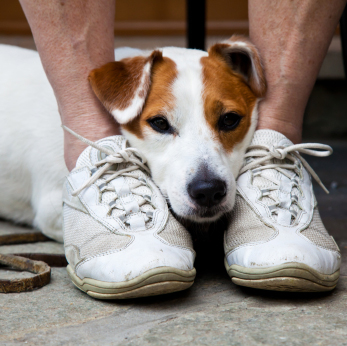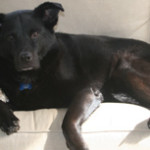 It’s raining right now which means Winston won’t leave my side and hasn’t been outside to go the bathroom since 10p.m. last night despite me efforts. I actually walked him all the way to the back of the yard hoping he would go if I went with him. It’s been 12 hours since he’s gone to the bathroom…
It’s raining right now which means Winston won’t leave my side and hasn’t been outside to go the bathroom since 10p.m. last night despite me efforts. I actually walked him all the way to the back of the yard hoping he would go if I went with him. It’s been 12 hours since he’s gone to the bathroom…
If a storm hits at night with lightning and thunder he is scratching at the bed and trembling. I do my best to make him feel safe and protected by creating a small, tight space between the bed and a table where he can lay with my hand on him. During the day I will turn on music, tv, extra lights anything to dull out the noise and light. I even tried the Thundershirt. I don’t remember him always being afraid of storms.Why are dogs afraid and what can you do?
It actually appears to be a common problem in dogs to be afraid of loud noises such as thunder, fireworks, guns etc. In Holly Nash’s article on Doctors Foster and Smith peteducation.com website, she noted that a recent study conducted showed “certain breeds of dogs have an above average risk of developing noise phobias” like “Collies, German Shepherds, Beagles, and Basset Hounds.” “The study also found that dogs who had separation anxiety were more likely to also have noise and thunderstorm phobias.”
Patty Khuly, a vet in Miami wrote an article for USA Today called “10 Steps to calm dogs during lightning storms.” I was doing some of the things she suggested as well as others intuitively:
Few tips to help your pet during storms:
1-Create a safe place for your pet. It could be a crate, closet, some interior space that feels safe and is comfortable.
2-Try and mute the noise-move to a quieter location and add other calming noises-music, fan etc.
3- “Counter the effects of electromagnetism” “Though it may sound like voodoo, your dog can also become sensitized to the electromagnetic radiation caused by lightning strikes. One great way to shield your dog from these potentially fear-provoking waves is to cover her crate with a double layer of heavy-duty aluminum foil. Another method involves clothing her in a commercially available “Storm Defender” cape that does the same work. If she hides under the bed, consider slipping a layer of aluminum foil between the box-spring and mattress.”
4- “Offer treats, cuddlings and other good stuff when storms happen.” “This method is best employed before the phobia sets in –– as pups. Associating loud booms with treats is never a bad thing, right?”
5- “Desensitize him.” “Sometimes it’s possible to allay the fears by using thunderstorm sound CDs when it’s not raging outside. Play it at a low volume while plying him with positive stimuli (like treats and pettings). Increase the volume all the while, getting to those uncomfortable booming sounds over a period of weeks. It works well for some.”
If nothing is working, talk to your vet about possible medication or a referral for a veterinary behaviorist.
I am thankful Winston’s response seems minor in comparison to others. Nash’s article offers an extensive list of noise phobia signs including: “Hiding (most common sign in cats), Urinating, Defecating, Chewing, Panting, Pacing, Trying to escape (digging, jumping through windows or going through walls, running away), Drooling, Seeking the owner, Expressing anal glands, Not eating, Not listening to commands, Trembling or shaking, Dilated pupils, Vocalizing (barking or meowing).”
My sister in law, who is a vet, rescued a Border Collie when he was two. After years of enduring bad storms in southern Florida and heightened stress, anxiety and destruction she choose to let her parents, who lived in the midwest, care for him. While it was incredibly sad to not have him around daily, he was much happier in an environment that was less stressful.
Other helpful articles:
“Fear of Thunder and Other Loud Noises” Adapted from material originally developed by applied animal behavorists at teh Dumb Friends League, Dencer, Colo featured on The Humane Society of The United States
“Thunderstorms: Help Your Pet Conquer Fear” Drs. Foster & Smith Educational Staff








